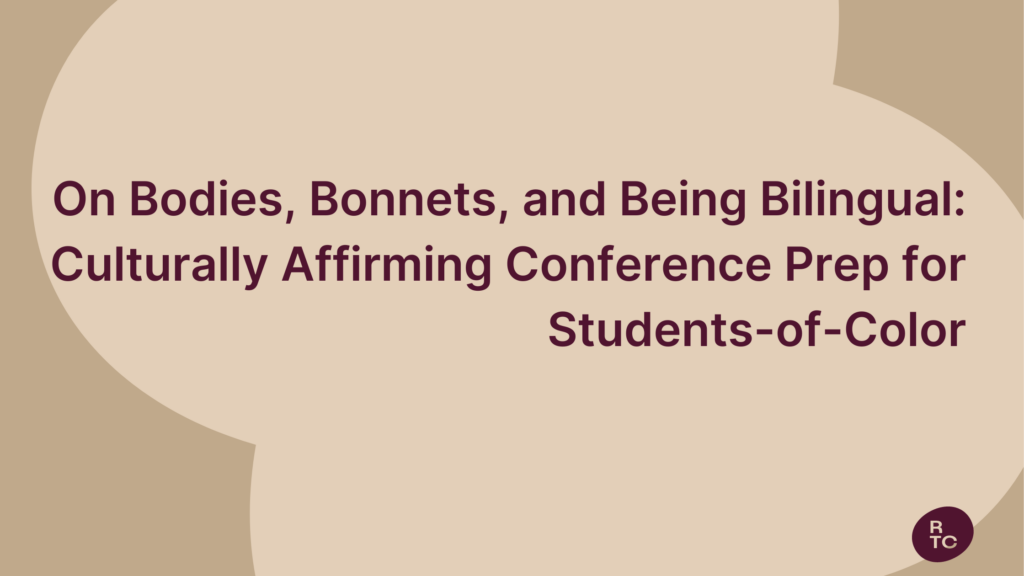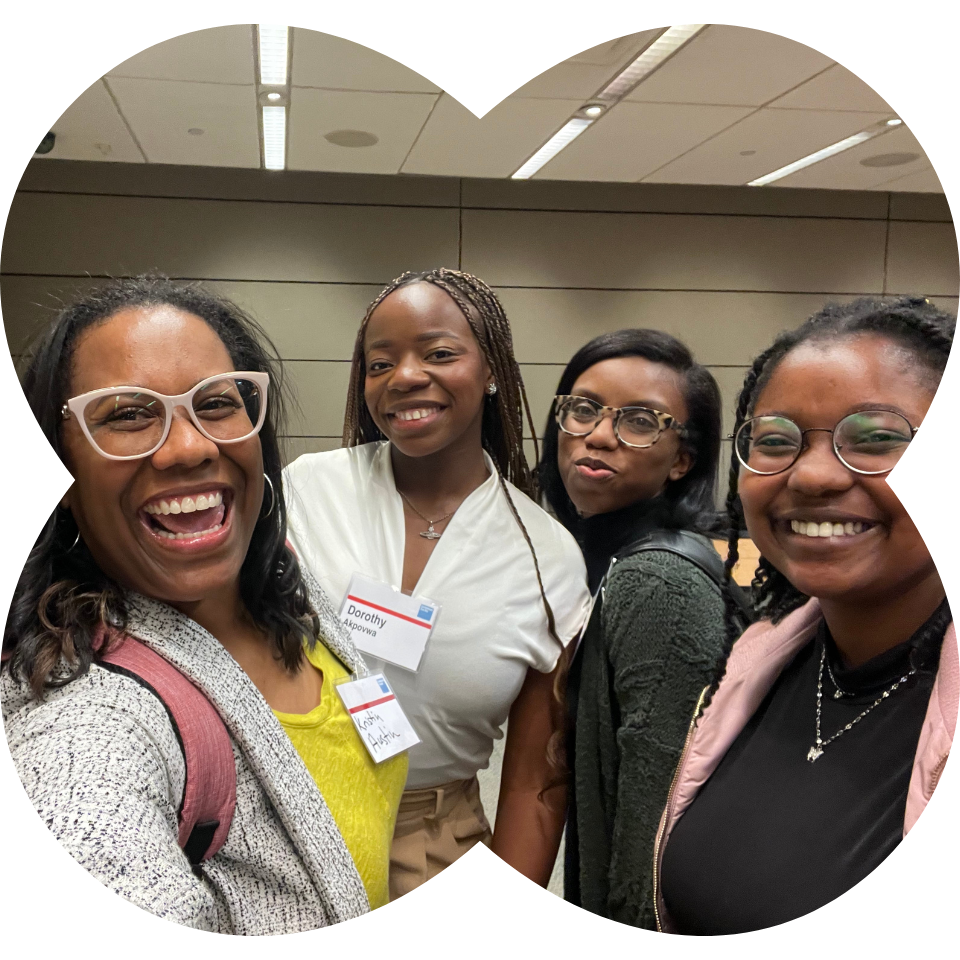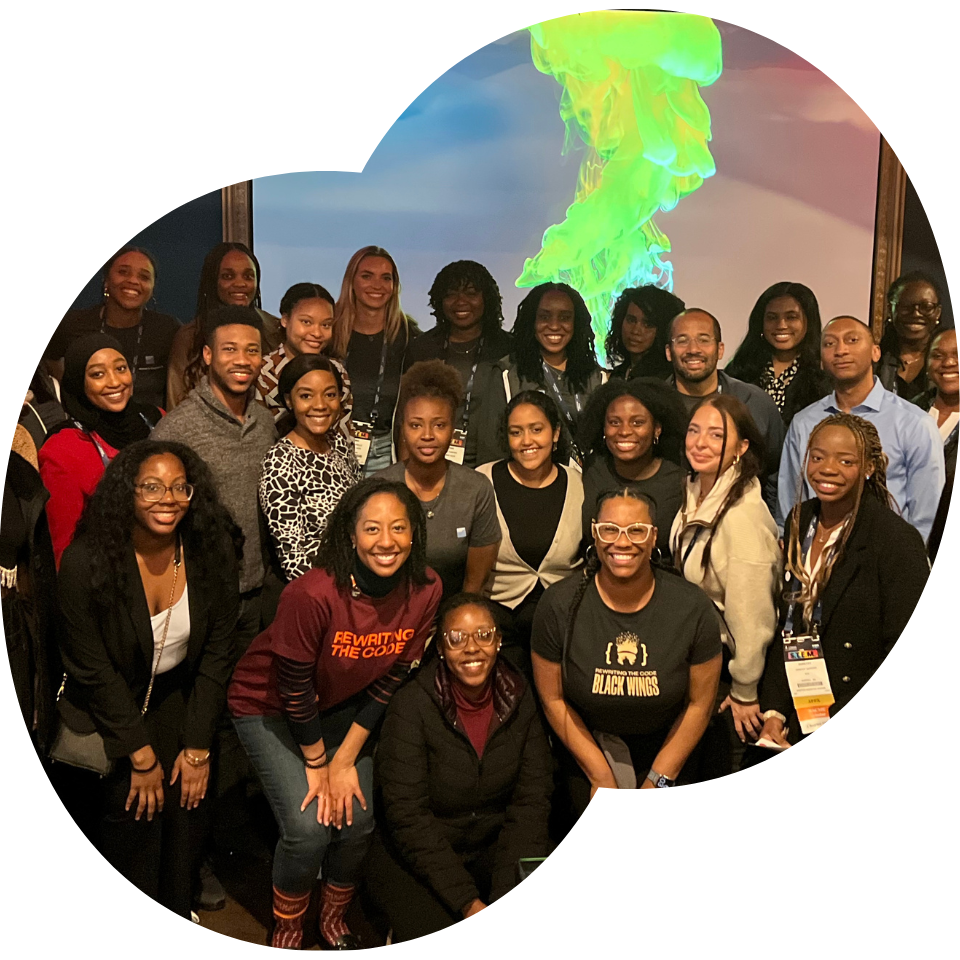
Written by Dr. Kristin Austin, Vice-President of Inclusion, Diversity, Equity & Access for Rewriting the Code
As Vice-President of Inclusion, Diversity, Equity & Access for Rewriting the Code (RTC), I empower Black, Latina, and Native American (BLNA) college women to be who they are: bold, brave, disruptive leaders in tech. However, even with these characteristics, the environments in which students are often learning try their best to silence their boldness, taunt their bravery, and shackle their disruption. Thankfully, organizations like RTC provide an affirming space where women can be their complete and powerful selves in all settings, including when attending professional conferences.
Reflecting on my 20+ years of higher education and student affairs career spent equipping students’ personal and professional success, I can identify ways traditional professional conference preparation has been problematic, ultimately contributing to gatekeeping and reinforcing cultural erasure. For example, when higher education primes students for a professional conference, the coaching often centers on how to behave, meet societal expectations, and accumulate likeability points during that make-or-break first impression. Rarely have I observed this coaching to include the importance of cultural identity and pride. Instead, students are taught to shapeshift and imitate based on what the conference wants to see rather than what the conference needs to embrace. This expectation is not OK, and I am not above admitting I was once a part of this problem.

Thankfully, I have grown in understanding privilege, oppression, power, and erasure. This evolution has led to me deeply investing in making sure students are empowered in their whole selves as they develop their professional identities. I want students to shine at their chosen wattage vs. shrink or align based on the world’s setting. Although I wish someone had given me this same permission as a college student, the fact that no one did amplifies my desire to be that for others.
My responsibilities at RTC include overseeing professional development opportunities that empower BLNA women. These experiences include annual trips to large and well-known international tech conferences. Today, when I prepare our students for these experiences, my priority is to ask, “How do YOU want to show up at the conference?” This question differs significantly from “How does the conference want you to show up?”
After a thoughtful pause and repeating the question a few more times, I can see light bulbs illuminate as my approach catches students off guard. Typically, students are accustomed to conference prep sessions where they are coached on resume structure, what to wear, and scripts for an elevator pitch. Sure, these things are essential. And we will eventually get to all of that, but it is certainly different from what’s most important. When supporting BLNA students navigating predominantly White and privileged conference experiences, document margins and fonts on a resume are the last things I am worried about. So instead, I focus on students understanding how to wear cultural strength and pride, not how to wear a stiff blazer.

Let’s be honest; professional conferences are often ableist, performative spaces where likeability and privileged identities occupy all the front-row seats. Such conferences often remind me of professional musical chairs: there is a declining balance of seats, and each chair can only fit someone with one body type, a neurotypical brain, and the reaction speed of Allyson Felix. So what would changing conference preparation from musical chairs to a musical circle look like? In the latter, everyone has a seat, and how you show up is not based on the size of a single chair but instead on the openness of a harmonic circle.
So, back to my guiding question for students, “How do you want to show up at the conference?” The answer to this question takes conference prep in a new and fresh direction.
Body Diversity
Black and brown bodies have consistently been the target of unfair criticism and are often hyper-sexualized. As such, “professional” clothing on one body type has simultaneously been deemed unprofessional on a different body type or racial identity. In my conversations with students, we lean into how our body contours are powerful and how we can represent that power in attire that is both accessible and confidence-boosting. We discuss what it means to dress “professionally confident” instead of “business professional.” We celebrate symbols of cultural pride and how we can incorporate them into our attire. Finally, we support each by sharing products and clothing items made by and for curvy women.
Our Crowns
In case you didn’t know, ethnic hair has recently been a subject of legislation and has long been a subject of discrimination. Yep. You read that right. Hair that grows naturally from one’s head is being legislated. You can’t make this stuff up, folks. So, when I get together with my BLNA students, we discuss empowered and healthy ways to wear our hair, not conformity-based ways to tame our hair. Our discussion is one of lace fronts and wigs; luxurious locs and two-strand twists; and, of course, knotless braids or naturally knotted afros. All beautiful. And all equally affirmed.
The Power of the Tongue
Many of our students are bilingual, and the beauty of their dual expression can be observed in the added flair of their accents. Ironically, multilingualism is applauded when White identities communicate in more than one language. However, BLNA students are expected to be English-speaking monolinguists, or else their intelligence and abilities are questioned. Sadly, the beauty of an accent can cause students to invest so many hours and emotional labor into concealing how they naturally speak that it inhibits their ability to focus on what they are actually saying, which really matters. Knowing this, I encourage students to embrace their natural communication.
Nicknames are for Family & Friends
Another concern frequently raised by our BLNA students is introducing themselves when their names are multisyllabic or don’t fit neatly into the standard English lexicon. Often, students are concerned about recruiters’ reactions to their names. In an attempt to “not be too much trouble,” students may default to erasure or conforming by replacing their given name with a “basic” or “American” name. In response to this decision, I always ask, “Is that a name friends and family call you?” Or, “Is that a name you feel confident responding to?” If I’m really being tough, I’ll push with, “Is this a name you created to make your existence easier for others?” I’m all for nicknames that conjure feelings of confidence and joy. However, I will not encourage students to change their identity because the world has told them their name is “too hard.” Instead, I coach our students to lean into their name proudly and highlight its beauty as part of their introduction. The power and confidence that comes from introducing yourself while adding, “My name is Esperanza, which translates to ‘hope’….” Or, “My name is Ayowunmi, which is Yoruba for ‘bringing joy’…” is unmatched. This shift from “nickname” to “name power” sets a strong tone, allowing them to show up fully from that first interaction. It’s a way of exclaiming, “I deserve to be here! And so does my name.”
Once we’ve done all the unpacking of supremacy and repacking of cultural affirmation, then we get to shift the conversation to other tools they’ll need, such as a strong resume. Fortunately, the students feel much more confident when we get to these topics. You see, a great resume and a firm handshake are not going to touch any of the deeper concerns BLNA students have about showing up to a professional conference. Students need to feel strong and powerful on the inside long before they can articulate those virtues on a resume.
In the end, as much as we are preparing students for personal and professional success, we are also preparing the workforce for an incoming generation of bold, brave, disruptive leaders in tech. In a social climate screaming about diversity and inclusion, companies must understand that priority starts with how you hire, not whom you hire. Fortunately, I get to have these hard conversations with Rewriting the Code’s company partners, but there is still so much work to be done. All of us have room for improvement, but BLNA students should never be expected to uphold standards designed to break them just to land a role.
As we endure the critical work of disrupting gender and racial inequity in tech, Rewriting the Code will continue preparing our members for the best and brightest opportunities in tech. However, long before I tell them to review a company’s website in advance of a recruitment event, we’ll first be giggling about bonnets, butters, oils, empanadas, which Telfar to bring, and how big is too big when it comes to hoops (because #IYKYN). That way, you get the best of them, not less of them.
Stay connected with RTC through Instagram, Facebook, and LinkedIn, or join our community of 18,000+ women in tech at teamRTC.org.